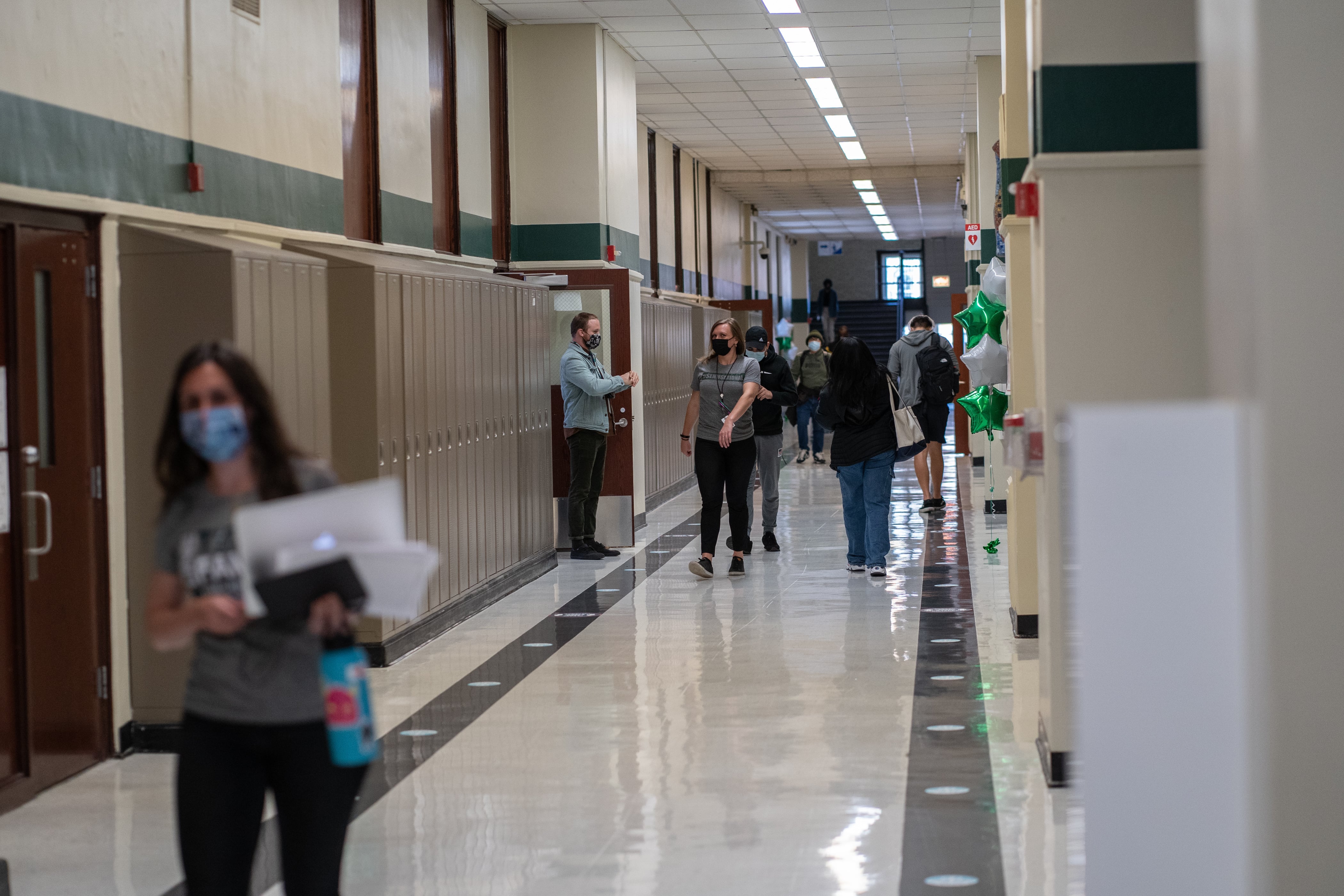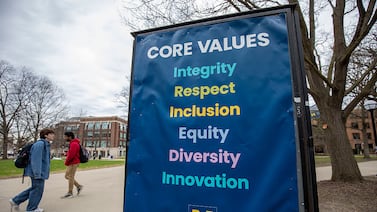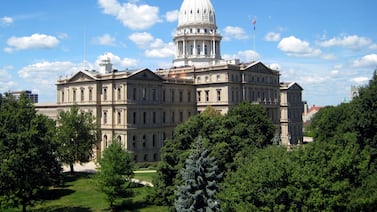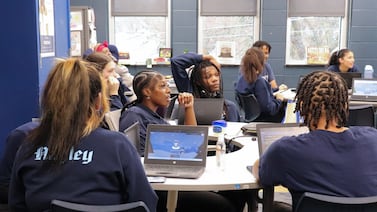Chicago Public Schools has seen a sharp increase in employee departures since this past summer, including its principals, with resignations and retirements more than doubling since the same period last year.
In the first seven months of the current fiscal year, the pace of turnover picked up among all employee groups, from central office administrators to school support staff. Teacher retirement and resignations jumped roughly 85%.
Those increases mark a shift: The number of educators and staff leaving the district had previously dipped during the pandemic, continuing a pre-COVID trend of marked declines in employee retirements and resignations.
One notable increase was among school leaders, whose departures tend to be especially disruptive to a school community — more so during this school year’s high-stakes, challenging transition back to full-time in-person learning. In all, 72 principals and assistant principals have left the district since July, already more than the number that retired or resigned during the entire 2018-2019 year.
Nationally, there is still little evidence that teachers and other school workers are leaving their jobs en masse, despite a string of surveys over the past couple of years capturing low morale, COVID fears, and thoughts about switching careers.
Still, the Chicago data obtained by Chalkbeat might be an early harbinger that some educators are starting to act on these thoughts, as the pandemic drags on and the return to campus full-time tests schools.
Here, after years of steady declines, the district’s turnover rate remains relatively low even with this year’s uptick.
Amid severe staffing shortages and heightened student needs, the transition back to full-time in-person learning has stretched principals across the country to the limit, said Scott Treibitz of the American Federation of School Administrators. This school year, some of the group’s members have driven school buses, served as crossing guards, cleaned school bathrooms, served food in cafeterias, and stepped in to substitute teach.
“School leaders are overwhelmed by the mounting workload, the mental health of students, teaching staff, and support staff,” Treibitz said. “I call them the unsung heroes of what’s going on in education right now.”
At Wednesday’s CPS board meeting, Bogdana Chkoumbova, the district’s new chief education officer, said the district is hosting a principal summit later this week to discuss how schools are navigating the district’s pandemic recovery.
“The support and engagement of our school leaders will continue to be a priority of mine,” she said.
This year brings a reversal in CPS employee departures
Until this past summer, Chicago appeared poised to continue a steady trend of declining employee turnover. During the 2020-21 fiscal year, departures across employee groups were down by more than a third compared to 2017-2018. The district did see a 25% jump in retirements over the previous years, but because of those earlier declines, their numbers remained well below pre-pandemic levels.
Officials and educators have said that a tangle of factors likely played a role in employees staying put: lingering economic uncertainty, the district’s stepped-up retention efforts, and pay and benefits that are markedly higher in Chicago than many suburban districts. The district last summer also touted gains in hiring for tough-to-fill special education positions and in hiring more Black and Latino educators.
This year so far, however, more teachers and other employees are leaving than right before the pandemic.
During the first seven months of this fiscal year, 1,842 employees resigned and another 524 retired, a more than 50% jump over the 2019-2020 year. The district employs about 39,000 workers.
This fall’s numbers also show that nonunionized central office workers left at higher rates than before the pandemic. About 250 left since the start of the fiscal year, compared with roughly 110 during the same period two years ago.
Those resignations and retirements continue a string of high-profile departures since former CEO Janice Jackson and her second- and third-in-command announced last spring they were leaving the district.
More than 1,240 teachers left earlier this fiscal year, up from 770 during the same period in 2019-2020. Support staffers saw a significant increase in resignations and retirements over last year, but because those numbers had plummeted from the year before, the overall jump compared to pre-pandemic times was not as sharp.
The bulk of the retirements and resignations across employee groups took place in the final months of the summer before the start of the school year. The district saw higher-than-usual numbers in August, which officials at the time said might be due in part to an employee vaccination mandate that the district has since relaxed.
But some departures have trickled in since. About 120 teachers and six principals retired or resigned in January, when the district customarily sees a slight uptick in departures ahead of the start of the second semester.
At Wednesday’s school board meeting, member Luisiana Melendez urged the district to step up efforts to support the mental health and wellness of teachers and school leaders.
“This has been a tremendous stress on them,” she said. “If the adults who take care of the children are not well, the children can’t thrive.”
Statewide, according to data from the Illinois Teacher Retirement System, educator retirements increased during the 2020 calendar year over the year before after years of declines. But they dipped again last year, to about 4,200, remaining only slightly higher than they were on the eve of the pandemic.
Chad Aldeman of the Edunomics Lab at Georgetown University, who has closely tracked data on school district turnover, said fall numbers from a few states he has seen so far suggest an rise in turnover heading into the current school year, though one that remains roughly in line with historical trends.
But there has been little data out yet on the school year underway, which has challenged educators and administrators with staffing issues, a rise in disruptive student behaviors, and the draining task of addressing the pandemic’s academic and mental health fallout.
Clearly, the pace of turnover in Chicago appears to be picking up, Aldeman said. After hitting a low of less than 5% last year, turnover this year is on pace to exceed the 2017-2018 rate of roughly 8%.
But Aldeman notes, “That’s still very low compared to national averages for teachers, let alone all employees in other sectors.”
Pandemic took a toll on principals
In Chicago, the turnover rate was highest among school leaders. Treibitz said the pandemic has been especially hard on principals and assistant principals, who have been on the frontlines of public schools’ response.
They were often in their buildings during last year’s remote learning stretch, overseeing the distribution of meals, computers, and other tasks. They have been in charge of enforcing COVID safety protocols — and sometimes on the receiving end of parent anger at how schools have navigated the outbreak.
The pandemic has also brought a slew of campaigns to unionize principals in districts across the country, including Chicago, Treibitz said.
In a statement, the district said it stepped up engagement with principals this years: Martinez is hosting biweekly calls with school leaders, and the district is reviving its principal advisory council. It also boosted its compensation package for assistant principals.
“Like other industries, our staffing and retention rates have been impacted by the COVID-19 pandemic,” the CPS statement said. “The district strives to create a working environment that allows for career advancement in an effort to retain its staff.”
Here, the Chicago Principals & Administrators Association is pursuing a push to allow district school leaders to form a union in the state Legislature, an effort the school district opposes. Since 2019, the American Federation of School Administrators, with which the Chicago group is affiliated, has added 11 new locals, including in Denver, after years of relatively flat membership. The group is also working with a number of districts where principal unionization drives are in the early stages.
Over the past year, the association has pushed its members to prioritize self-care, cautioning them against neglecting their mental health needs as they scramble to troubleshoot on campus.
“You have to put your oxygen mask first,” Treibitz said, “or in the long haul, it won’t be good for the community you are trying to serve.”
Mila Koumpilova is Chalkbeat Chicago’s senior reporter covering Chicago Public Schools. Contact Mila at mkoumpilova@chalkbeat.org.







